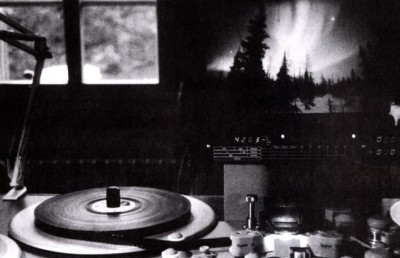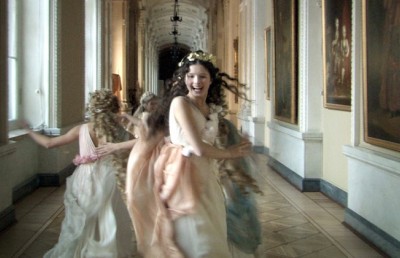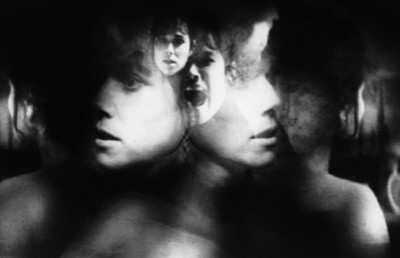“Mettlerism”: Fleeting Moments of Transcendence

Encounters and valedictions, summons and replies: the communication of meaning implies an act of the heart, an openness that may lead to embarrassment and pain, muddle and contention; but that communication also trusts that something will come, something essential will be passed on between people, between the cosmos and ourselves. 1
- B.W. Powe (A Canada of Light)
We, as Canadians, have a decisive role in exploring the possibilities and boundaries of identity and how unique, disparate identities relate to our essential being. The fallout of history has granted us this function and Powe has taken the initiative, carving out a version of the Canadian experience that is both poetic and perceptive; inscribing an impersonal history with personality and demonstrating how similar we all are regardless of ethnic, geographic or demographic background. Peter Mettler has a similar role, but his process is altogether unique. He captures reality (vaguely defined for our purposes as moments or history which can be filmed and preserved in some form or another), observes that reality, relates moments to each other, and then frees the contents via images in fleeting moments of transcendence. The process has been described as one of “Mettlerism”. And the totality of his effect can be achieved given a limited arsenal: a camera, several subjects, curiosity (often in the form of questions or comments), discriminating observation, imagination, and an openness to experience and communication that cannot be taught, only skillfully attained and employed.
His most ambitious work to date, entitled Gambling, Gods and LSD (2002), is a difficult, yet rewarding three hour episodic documentary that explores (in his own words, as narrator) “the state of people” in four locations: Toronto, Las Vegas, Switzerland and India. As the title suggests, the film consists of images often related to several underlying themes (i.e. addiction, technology, divinity, nature, illusion, reality etc…) but the film’s potency stems from its ability to eschew traditional narrative, or any other conventions of the documentary film form for that matter. It is a unique, enriching experience that grows with subsequent screenings, especially when considering the layers upon layers of aural and visual stimuli that lie at the core of its process; a communal process that he, as filmmaker, and we, as spectators, are mutually and acutely aware of. While it may seem premature to call “Mettlerism” a new language, it is indeed a new way of perceiving, given the traditional properties of the cinematic medium. Getting a film of this stature to the public is a daunting task; getting a public, which regularly digests the visual equivalent of fast food, to understand it for what it is and how it communicates is harder yet. Here Mettler & Co. can not rely on word-of-mouth or critical appraisal alone. In fact, if you are reading this article it is probably for one of two reasons: A) you have seen GGLSD and you have an inexplicable urge to re-confirm the sensorial pleasure that the film provided you with; or B) you have or have not seen the film and you want to understand what all the fuss is about and why so many are departing before the film’s closing credits (and this was the case at a cinema I worked at during the film’s premiere in Montreal). Apparently, a similar ordeal, though notably on a lesser scale, occurred in 1968 with Stanley Kubrick’s 2001: A Space Odyssey. And if Kubrick’s masterpiece works as a benchmark of intellectual maturation (and seeing that film twenty years apart does indeed serve as an indicator of intellectual growth), then Mettler’s film serves as a sensorial benchmark, providing an approximate indication of one’s sensual growth.
"Maybe there is a difference between looking for something and looking at something, when you are a part of what you are looking at, and you look at it and it looks back at you." (Gambling, Gods and LSD, 2002)
For a film GGLSD is a remarkably sensorial experience, more so than the average fare. Sound and image are combined in innovative ways, constructing an external reality from the internal if not eternal pulse that dominates and penetrates the essence of our being. ‘Penetrate’, you say! Granted, a slight rephrasing is in order. Penetrates the essence of an open being may be more appropriate, for this is a film experience in which one must leave his/her inhibitions, attitudes, or vices at the door. As in regards to the opening quotation, “…the communication of meaning implies an act of the heart, an openness…” so we must welcome Mettler’s open-hearted communication with an open-hearted reception to fully experience his vision. Even then, there are those who require at least some semblance of plot contrivances, the need to propel the series of events that constitute the fiction film. In the case of GGLSD, a series of episodic header titles will not suffice in stringing many viewers along. Or, on the other hand, the vain intellectuals who feel obliged to cast some degree of interpretation on the film in order to justify or counter-balance the sense of understanding that cannot be conveyed with words, only images. It was, after all, Susan Sontag who declared that “interpretation takes the sensory experience of the work of art for granted, and proceeds from there.” 2 This does not mean that the film evades interpretation, nor that we should depreciate the film’s content. Rather, we should revel in the sensorial pleasures that the total film experience transmits to our essential being, devoid of society’s material and sensual excess, which in Sontag’s own words “conjoin to dull our sensory faculties.” 3
Mettler, in the interview I conducted which complements this article, spoke of a ‘consciousness’ which accompanies both film and video cameras respectively. He is aware of this consciousness more so in GGLSD than in any of his films because the cameras, which were being carried around throughout his travels, became an extension of his vision. In fact it is not uncommon for Mettler to intersperse segments of camera manipulation as he controls and varies the exposure, focus, and camera speed according to his perceptual bias. He is constantly reassuring the viewer that the images are his, formations of one man’s perceptual reality, which is nevertheless a deserved subject to scrutiny. And when we observe and scrutinize we witness the shaping of a truth and reality that take place in the film’s unfolding spatial-temporal (dis)-continuum. The real truth is not in the images themselves, but in how they have been related and manipulated; the way in which the film takes shape or form is much more akin to how we experience the world than your average fictional narrative. An integral part of Mettler’s approach is abandoning the cumbersome, bloated scope of most film productions, giving him superior mobility and the ability to capture the rhythms, behaviors and actions of widely divergent peoples while identifying and foregrounding the perceptual reality that each of us share indiscriminately.
If we are all similar beings (in essence, of course) then images would seem to do more justice in supporting that argument than words, if only because words are inert and human behavior is not. And if, as so many have professed, technology is well on its way to enslaving humanity, in the Heideggerian sense, then it may take technology in the form of art (i.e. cinema) to free our essence from its clenches. It may require the camera eye to identify and free humanity’s essence from the obscured malaise that represents his/her present state of affairs. And it should also come as no surprise that the fulfillment of art in preserving humanity’s essence be a precept of Heidegger’s philosophy, considering his treatise on art entitled Poetry, Language, and Thought.
Nothing seems to exist unless it can be captured as an image (Picture of Light, 1994)
If digital photography is the wave of the future, then the Mettler’s of the film world, who are searching for a purer cinematic process, will have to contend with the George Lucas’s, who are trying to standardize the mainstream. The image quality of GGLSD will undoubtedly befuddle the mainstream cinema-goer, who is used to a standard; the standard which most lefties (including the Danes i.e. Dogma ‘95) have been trying to displace, replace or better yet dismantle, since the dawn of independent cinema. Mettler diligently interweaves both film and video footage in a manner that (pre) serves the specificity of each: the somewhat premeditated, sublime imagery is captured with the film medium; whilst the more spontaneous, instinctive imagery is captured with video. This process enabled a selection of images from a foundation that consisted of over fifty hours of footage.
And for those doubting Mettler’s proficiency as an artist, it will suffice to glance for a moment at his impressive oeuvre. Top of His Head (1989) is a dense work of fiction that he wrote, co-edited, and directed. Picture of Light is a painstaking effort to successfully capture the essence of the Aurora Borealis (a.k.a. Northern Lights), and he has seen no shortage of collaborations (as cinematographer) with a list that reads like a who’s who of Canadian cinema: Atom Egoyan, Patricia Rozema, Bruce McDonald, and Jeremy Podeswa amongst others. The problem for Mettler, one that recurs regardless of the demands of the project at hand, resides in reaching a public who are somewhat indifferent to a Canadian cinema, via an industry that does not necessarily support or promote indigenous talent. Having spoken to Mettler candidly, I was overcome by his sense of hope and longing for a progressively charged independent industry. It may be premature to gauge the success and appraisal that GGLSD has garnered thus far, but judging by its reception upon its premiere in Montreal, it has the potential to trigger a new mode of film production and inspire a whole new generation of visual artists.
Notes
- Powe, B.W. A Canada of Light. Coach House Press, Toronto, 1993. p. 34. ↩
- Sontag, Susan. Against Interpretation and Other Essays. Farrar, Straus and Giroux, 1966. p. 13. ↩
- Ibid., p. 13 ↩













